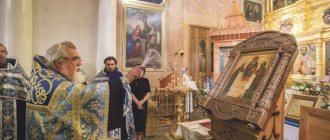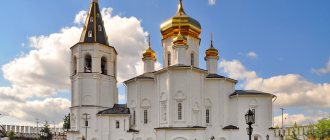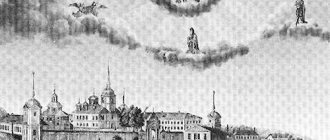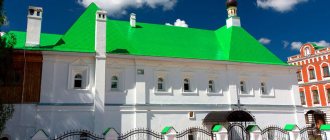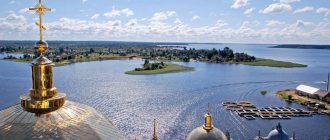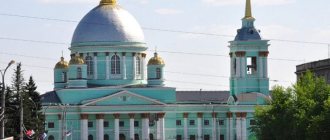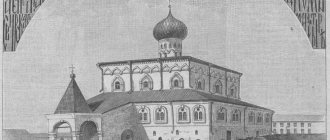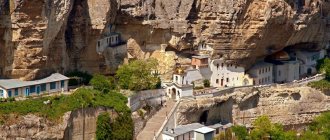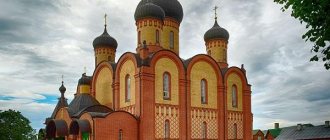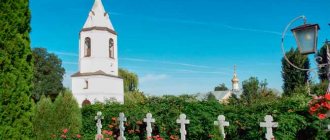The Trifonov Monastery is located on the river bank in the historical center of Kirov. The Assumption Cathedral of the monastery is the oldest building in the city and the oldest Vyatka Orthodox church built of stone, which was lucky enough to survive to this day. Now the cathedral has the status of a federal architectural monument with a three-century history.
The Trifonov Monastery in Kirov arose thanks to an amazing person - the monk of the Pyskorsky Monastery Trifon; in 1580 he appeared in the city and intended to organize a monastery here.
The townspeople supported Tryphon's idea, and he went to Moscow with a petition to Tsar Ivan the Terrible himself. The mission of the ascetic was crowned with success. The royal charter granted Tryphon the right to the lands allotted to them for the monastery, and a number of populated villages, lakes, meadows and plots of land for arable land. Tryphon himself was ordained as a hieromonk and appointed to lead the construction of his monastery.
Tryphon returned to Khlynov already in the status of abbot of the future monastery. A year later, the first temple, the Assumption Church, was built in the new monastery. The church had six roofs and five side chapels. And again Tryphon went to Moscow for help - the time had come to decorate the inside of the building and fill it with church utensils.
The new sovereign, Theodore Ivanovich, also greeted Tryphon and the ascetic returned with a dozen carts loaded with icons, vestments, Christian books and church utensils. In 1589 the temple was consecrated, it became a cathedral for the monastery, also called Assumption.
In the 17th century, a high bell tower, residential cells, utility rooms and a chapel were added to the ensemble of the Trifonov Monastery: it marked the holy spring, which, according to monastic tradition, was equipped by the Monk Tryphon himself.
A century after the consecration of the wooden Assumption Church, it was replaced by a majestic stone cathedral; it was built from 1684 to 1689. It became the first stone church in the Trifonov Monastery and the third stone building in Khlynov, and today, after their loss, the Assumption Cathedral remains the most ancient building in the city.
When laying the foundation, the coffin of the deceased Tryphon of Vyatka was discovered. The relics of the saint were transferred with all due honors to the cathedral along with his personal belongings.
On May 31, 1689, the Assumption Cathedral was solemnly consecrated; since then the temple has become the main building of the Trifonov Monastery of Kirov and continues to correspond and look consistent with its high purpose. This is the true architectural dominant of the entire monastery ensemble.
After the revolution
The Trifonov Monastery of Kirov was dissolved in 1918, the monks were expelled, but thanks to the ascetic Yulia Lavrovskaya, an Orthodox community was organized within the walls of the monastery, which pledged to use all the churches of the monastery exclusively for worship. In 1923, the monastery was captured by representatives of the schismatic Renovationist Church. But they didn’t last long either. In 1929, the literal destruction of the monastery began.
Even in the pre-war years, a hostel was “registered” in the holy monastery, served by a dining room with a laundry, and soon communal apartments of the housing stock began to be equipped here. They quickly added a bakery, a shoemaker's workshop, and branches of various educational institutions. When the war ended, the territory of the monastery was chosen by a local electromechanical plant, which located an iron and steel foundry in the temples.
Without proper care, many of the monastery's buildings simply fell apart; only in 1980 was a project drawn up for the restoration of the entire monastery complex as a single architectural ensemble.
In 1989, the Assumption Cathedral was returned to the church, and two years later the entire monastery was transferred to the diocesan administration, the Holy Synod blessed the opening of the Holy Dormition Trifonov Monastery.
Soon the pride of the monastery, the Assumption Church, was restored. After the transfer of the Trifonov Monastery to the Kirov diocese, this wonderful temple acquired the status of a cathedral.
History of the monastery
The founder of this ancient monastery is Saint Tryphon of Vyatka. It was he who suggested that residents of nearby areas turn to Tsar Ivan the Terrible with a request to erect a monastery complex. In 1580, the ruler approved the petition and issued a charter to Tryphon for the construction of the monastery.
Assumption Trifonov Monastery in Kirov
The foundation site was made into the territory of an abandoned city cemetery, on which stood two dilapidated chapels. Ivan the Terrible donated villages, meadows and lakes to the monastery, and Tsar Theodore Ivanovich continued the donation, who donated various utensils, holy books, icons, as well as land to the complex.
By order of the ruler, the territory around the complex being created was settled by peasants from nearby regions.
- Thanks to rich donations, St. Tryphon built four churches in the monastery. The first was the temple consecrated in honor of the Annunciation of the Virgin Mary, the second was the Assumption. In the first years of the 17th century, monastic cells, a bell tower and the necessary outbuildings appeared here. The monastery complex was surrounded by a wooden fence, on the northern side of which there were two entrances. Behind the fence there were a stable and a barnyard.
- Saint Tryphon organized a strict rule of community among the brethren. The monks had a common refectory and property; they were forbidden to drink wine, visit or invite anyone to their cell. Liturgies were celebrated daily in the main cathedrals of the monastery. However, the severity was not to the taste of some senior monks, so soon the Monk Tryphon was expelled. He was able to return to his native monastery only in the last years of his life, here he found eternal peace.
In the 17th century, the importance of the Tryphon Monastery increased. Archimandrites became abbots, and holy elders were sent to the estates belonging to the monastery, whose mission was to found new settlements and attract residents. The community not only expanded its territory, but also carried out active educational activities.
At this time, many churches and chapels were erected around the Tryphon Monastery. The complex acquired the status of a cultural center of the Vyatka lands, within its walls novices studied literacy and created literature. The rich monastery could quickly restore buildings damaged by the fire, and soon the construction of stone buildings began here.
On a note! Saint Tryphon was born into a wealthy family, brought up in a pious atmosphere, and lost his father at an early age. He took monastic vows at the age of 22 from Abbot Varlaam; he sought solitude, so he retired to the place where Perm is located today. He founded a monastery in the city of Khlynov in 1580 and received the rank of archimandrite. The saint was a strict ascetic, wearing chains and hair wool. Before his death, he left a blessed testament to his brethren; he died in 1612, and in 1903. The Church glorified him as a saint.
Further history
During the reforms of Peter the Great, the monastery was taxed, income from its lands went to the state treasury, which led to desolation and impoverishment. The community had no funds left to restore dilapidated buildings; this prompted the abbots to turn to the ruler himself for help.
In the middle of the 18th century, the peasants of the monastery estates rebelled against injustice. The secularization reform, approved in 1764, decreed that the Trifonov monastery would receive an annual salary of only 800 rubles.
Cancer with the relics of Tryphon of Vyatka in the Assumption Cathedral
Empress Catherine II confiscated many lands belonging to the monastery complex, and there were frequent fires on its territory.
- The monastery became so poor that the brethren had to open a collection for donations in front of the entrance gates. To improve the financial situation, the abbots had to organize processions of the cross with holy icons. The help of residents and some virtuous landowners allowed the monastery to maintain its buildings in good condition, as well as provide support to needy parishioners.
- From the middle to the end of the 18th century, a Russian-Latin school operated on the territory of the monastery complex, which after a while was retrained into a theological academy.
- The best lands of the Tryphon Monastery were returned by Emperor Paul the First. In the 19th century, Archimandrite Ambrose began to rent out the monastic estates, which significantly improved the financial situation of the complex. In 1865, a boarding house for its students was built next to the theological academy. Soon a school for city children was organized here. At the end of the 19th century, the Monk Stefan lived in the monastery, who significantly raised the level of the spiritual state of the community.
Before the revolutionary actions, the monastery complex was considered well-maintained, but small in number. The community received its main income from renting out apartments. Therefore, at the beginning of the 20th century, it was possible to repair the main cathedrals. In 1912, water supply was installed on the territory, the roof was strengthened, and two houses for pilgrims were erected.
Holy spring of St. Tryphon
Soviet period and modern times
In September 1918, the Soviet authorities officially closed the Trifonov Monastery and sent the monks to Perm. A hospital, a warehouse, and a party school were located on the territory of the monastery. Some churches continued to hold services thanks to the activities of some activists.
- In 1921, the Orthodox community, led by Bishop Victor, still lived in the monastery. However, two years later, the renovationist organization, with the help of the state, captured the central cathedral, and other buildings came under the control of various structures.
- In 1929, the bells were removed from the Assumption Church, sent for melting down, and the church utensils were sold or donated to the museum. Here the cemetery was desecrated and destroyed, as well as the iconostases and the bell tower. Various enterprises were located in the temple buildings. Most of the territory was occupied by metallurgical workshops.
- In the middle of the 20th century, parishioners began to turn to the city council with the question of returning the monastery. Believers offered restoration at their own expense, but the authorities always refused. The buildings of the monastery complex gradually came to destruction. Until 1980, only partial restoration work was carried out.
- In 1988, the area began to consider the issue of a full restoration of the monastery and its transfer to the community. More than 12,000 signatures were collected in support of the opening of the monastery. In the spring of 1989, the Assumption Cathedral was transferred free of charge to the administration of the Kirov diocese, and a year later a decree was issued on the full granting of a full-fledged monastery complex. In the fall of 1991, the Synod blessed the official opening of the Tryphon Monastery.
Divine service at the Assumption Trifonov Monastery
Soon the abbot's chambers, fraternal buildings, and the bell tower were restored, and a chapel was built above the storehouse. By 1994, the central cathedral was re-painted, the iconostasis and domes were restored, and the surrounding areas were improved.
Architectural ensemble[edit]
- Cathedral of the Assumption of the Virgin Mary (1684-1689)
- St. Nicholas Gate Church (1692-1695)
- Bell tower (1714, 1764, dismantled in 1935, rebuilt in 1994-1995)
- Church of the Three Saints (1711-1717)
- Annunciation Church (1728)
- Superiors' Chambers (1719, 1818)
- Brethren Corps (1742, 1831)
- Northeast Tower (1742)
- North-West Tower (1742, rebuilt in 1993)
- Monastery guardhouse (1740s)
- Fraternal cells and seminary (1764)
- Southwestern Tower (1774–1775, rebuilt in 1994)
- South-east tower (1774-1775)
- Monastic cookery (1769)
- Chapel of Tryphon Vyatsky (1684, demolished during Soviet times, rebuilt according to a new design in 1990)
- Boarding house for students of the seminary and theological school (1856)
- The abbot's summer house in the garden (1849)
Abbots
- St. Tryfon (Podvizaev) (1580 - mentioned 1601)
- Jonah (Mamin) (mentioned 1608 - 1617/18)
- Jonah (Kalyazin?) (1617/18 - mentioned 1627)
- Alexander (mentioned 1628)
- Gerasim (Putnikov/Kunitsa) (mentioned April–June 1632)
- Joseph (mentioned October 1634)
- Gerasim (Putnikov/Kunitsa), 2nd time (1635 - mentioned April 1636)
- Alexander (mentioned April 1643 - mentioned March 1646)
- Joachim (mentioned 1648/49 – mentioned October 1650)
- Alexander (mentioned 1653/54)
- Moses (mentioned June 1654 – mentioned 1657/58)
- Parthenius (1657 – 1658) (?)
- Sergius (mentioned March 1659 – mentioned April 1670)
- Job (mentioned March 1673 – mentioned 1675/76)
- Joel (mentioned July 1676 – July 1679)
- Alexander (mentioned March 1680 – 1715)
- Parfeniy (Kataev) (1715 - 1731)
- Paphnutius (1731 – 1733)
- Alexander (Korchemkin) (1733 - 1734)
- Lawrence (mentioned 1734 – 1739?) (viceroy?)
- Daniel (mentioned 1741 - 1744)
- Joasaph (Potemkin) (1744 - 1752)
- Nikon (mentioned 1754 - 1756)
- David (Uspensky?) (1756 - 1764)
- Zephaniah (Macedonian) (1764)
- Andrey (Tarshevsky) (1764 – 1771)
- Polycarp (Pavlovsky) (1772 – 1774)
- Tranquillin (1774 – 1776)
- Kallist (Zvenigorodsky) (1776 – 1796)
- Lavrenty (Dolmatov) (1796 – 1800)
- Misail (Sapozhnikov) (1800 – 1817)
- Justin (Sementovsky) (1817 – 1823)
- Theophylact (Pinegin) (1824 – 1829)
- Jerome (Nesterovsky) (1829 – 1834)
- Nikodim (Kazantsev) (March 19, 1835 – June 20, 1841)
- Ambrose (Krasovsky) (1841 – 1866 [3])
- Joseph (Bazhenov) (August 12, 1866 - 1868)
- Sarapul rulers (1868 - 1889)
- Glazov rulers (1889 - mentioned 1921)
- Vyatka rulers (since September 25, 1991)
- Job (Muravyov) (October 2, 1997 - October 5, 2011) abbot.
- Feodor (Rulev) (from March 16, 2012) abbot.
OK. 1923 - 1989 - the monastery and its churches were confiscated
History[edit]
Founded in 1580 (letter of Tsar Ivan Vasilyevich dated June 2 (June 11), 1580) by the Monk Tryphon of Vyatka, who came here from the Chusovsky estates of the Stroganov salt industrialists, on the southern bank of the Zasorny ravine, on the site of two ancient cemetery churches. First, he erected a wooden church in the name of the Annunciation, and around 1599, a unique wooden Assumption Church with 6 tents of different heights.
Next to the monastery, two monastic settlements soon grew up - a small one, behind the monastery, which was called Kikimorskaya, and a large one, near the monastery itself, which was therefore often called Zaogradnaya. During the first century of its existence, the Assumption Monastery remained wooden and completely retained its original layout, picturesquely complementing the silhouette of the city. In the next century, the wooden monastery churches, fences, outbuildings and residential buildings were gradually rebuilt in stone.
Among the children of the boyars who served in the 17th-18th centuries. in the archimandrite courtyard, the names of the Kholuyevs, Veprevs and others are known. In 1856-57. The future Saint Meletius (Yakimov) passed his obedience in the monastery.
In 1918, the monastery was closed; the Assumption Cathedral continued to function as a parish church for another 11 years (under the control of the Renovationists). The monks (there were 15 of them before the revolution) were sent to the “Kizelovsky concentration camp”, known for its difficult conditions of detention[2]. In 1935, part of the fence and the bell tower were demolished; by 1942, the southern wall and corner towers were dismantled into bricks. Communal apartments and dormitories were set up in the monastery buildings, a garment factory moved in, and the production of baked goods was established. For production needs, an oil boiler house was built on the territory of the monastery. The pre-revolutionary iconostasis was preserved only in the Assumption Cathedral, which was adapted to house the archive.
In the post-war period, the Three Saints and St. Nicholas churches came under the control of the regional department of culture. The first restoration work in the monastery buildings, which had fallen into extreme disrepair, was carried out in the 1950s; a new restoration campaign took place in the 1980s. It is alleged that during the work, ancient underground passages were discovered leading to a nearby nunnery[3]. The cathedral was transferred to the free use of the diocese in 1989, and two years later the entire monastery was restored.
The monastery necropolis was destroyed in the 1930s. At the end of the 20th century. Ancient tombstones began to be brought to the territory of the monastery, mainly from the destroyed city Theological Cemetery.
How to get there[edit]
Directions:
The monastery is located in the historical district of Kirov (Vyatka), not far from the central Lenin Street. Trains from Moscow to Kirov depart from Yaroslavsky station. Travel time is about thirteen hours. By car, you should leave Moscow along the Yaroslavskoye Highway and drive to Yaroslavl. At the entrance to the city, turn (right) towards Kostroma. In Kostroma - follow the signs to Sharya. The distance is a little less than 1000 km.
Address:
610000, Vyatka (Kirov), st. Gorbachev, vl. 4
Tel.:
Email:
